 Kentucky schools will get just over $2 billion dollars in a third round of Elementary and Secondary School Emergency Relief (ESSER III) funding from the American Rescue Plan Act (ARPA).
Kentucky schools will get just over $2 billion dollars in a third round of Elementary and Secondary School Emergency Relief (ESSER III) funding from the American Rescue Plan Act (ARPA).
At least 90% of that money will be allocated to state education agencies (SEAs) for distribution as subgrants to local education agencies (LEAs), Robin Kinney, the Kentucky Department of Education’s (KDE’s) associate commissioner in the Office of Finance and Operations told superintendents during the regular Superintendents’ Webcast on April 13.
The money, with allocations based on Title I funds each district received in the most recent fiscal year, will be available for use through Sept. 30, 2024.
The process for receiving the money will be the same as for ESSER I and II funds – districts will submit signed assurances and a spending plan, Kinney said.
“You will be providing that through GMAP as you have in the past,” she said.
One difference from previous ESSER funds is that not less than 20% of each district allocation must be used to address learning loss through the implementation of evidence based interventions and ensure that those interventions respond to student’s social emotional and academic needs and address the disproportionate impact of COVID-19 on underrepresented student subgroups. This may be done through such methods as summer learning programs, extended school days and after-school programs, Kinney said. The rest of the funds can be used for the same purposes allowed under ESSER I and II.
ESSER III additionally permits a 10% state set aside. ESSER III requires states to reserve 5% of the total funds to address learning loss and additionally requires states to consider equity based on high-need and high-poverty school districts, she said. Local districts also have a requirement to maintain equity in funding and staffing. More information on that will be forthcoming from the U.S. Department of Education (USED).
The funding includes $42 million for non-public schools in Kentucky.
Kinney said all ESSER funds will get an automatic one-year extension on their availability. That means a deadline of Sept. 30, 2022, for ESSER I, Sept. 30, 2023, for ESSER II and Sept. 30, 2024, for ESSER III.
The new funding can be used for salaries, including salaries for virtual academies, but districts need to lay out how that spending is related to dealing with COVID-19, Kinney said.
Supplemental School Year Program
Senate Bill (SB) 128 allows a supplemental school year for students to retake classes due to COVID-19-related disruptions in learning. Students seeking to do so must submit a written request to their district by May 1. Districts must decide by June 1 whether they will participate in the Supplemental School Year Program, said Meredith Brewer, KDE’s director of educational policy. Districts must submit their plans to KDE and by June 16. More information will come in a set of assurances via GMAP, she said.
Even if students plan to repeat a grade, they must take the end-of-year assessment for the grade they’re in, said Chuck Truesdell, KDE’s director of government relations.
Students who already have graduated but choose to repeat classes will not have any new grade counted, he said. Graduated seniors also are not eligible for dual credit or Work Ready scholarships.
Supplemental classes that students take must be the same as they had before or have a “reasonable connection” to their previous courses, Brewer said. Local school districts will determine whether courses have a “reasonable connection” to previously completed courses. Districts should look to academic standards tied to various course codes as a guide for determining which courses are supplementary in nature.
If students have completed all graduation requirements by the end of the 2020-2021 school year, they will graduate and receive a diploma, regardless of whether they wish to take part in the Supplemental School Year Program, Brewer said.
Students who have graduated but are repeating classes would be eligible to participate in athletics, as long as they are enrolled for at least four credit hours, said Julian Tackett, commissioner of the Kentucky High School Athletic Association (KHSAA).
Students repeating 8th-grade classes would not be able to play high school football or soccer during their supplementary year, but could be eligible for other high school-level sports, he said. Playing in those sports would not affect their four years of high school sports eligibility, Tackett said.
As long as students are enrolled in school full time according to KDE criteria, they are eligible to participate in some level of sports, he said.
“They can’t be totally separated from the secondary school environment and still play,” Tackett said.
Virtual Learning Options
Of Kentucky’s 170 public school districts, 143 already offer a full- or part-time virtual education option, according to KDE Chief Digital Officer Marty Park.
For traditional performance-based virtual programs for grades 5 through 12, the processes and structures are the same as before the COVID-19 pandemic.
For districts seeking to begin virtual programs for kindergarten through 4th grade, a one-year targeted waiver to certain sections of attendance regulations offers some flexibility for the 2021-2022 school year.
With approval of the waiver, students enrolled full-time in a virtual school, program or academy can be counted in the school’s overall daily attendance. The waiver requires that for elementary students, virtual attendance be counted twice a day instead of once to ensure full-day attendance, Park said. Virtual middle and high school students shall be counted at the course level for attendance.
Approval is based on a district’s assurance of several elements for high-quality virtual instruction.
“Districts cannot assign students to this option involuntarily,” Park said. Nor can students be placed in virtual programs solely due to disciplinary reasons. If virtual students are not fully engaged, interacting with teachers or not regularly attending, the district can require them to return to in-person classes, he said.
Healthy at School Changes
The latest revision of the Healthy at School guidance relaxes some standards per recent recommendations from the U.S. Centers for Disease Control and Prevention (CDC).
In classrooms, schools can reduce the amount of space between seated students from 6 feet to 3 feet, but a 6-foot distance must be maintained in common areas, said Kelly Foster, KDE’s associate commissioner in the Office of Continuous Improvement and Support. Middle and high schools should expect to return to 6-foot distancing between seats if local spread of COVID-19 becomes high.
Schools no longer have to do temperature screening of students and staff at the door of buses or buildings, but temperature should be checked when assessing students or staff who display symptoms, Foster said.
All other mitigation measures must remain in place. The changes are outlined on pages 6 and 7 of the Healthy at School document.



Leave A Comment